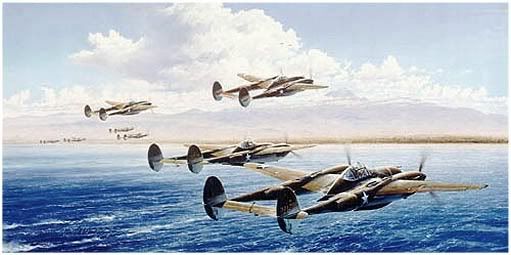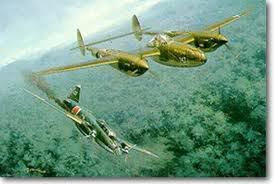THE HUNT FOR YAMAMOTO
The Mission
Major Mitchell, the CO of the 339th Fighter Squadron, based at Guadalcanal, headed over to the bunker with Tom Lanphier, one of his top pilots, where they met Admiral Marc Mitscher and "every brass hat on the island." It was April 17, 1943.
The senior Navy and Marine Corps officers took over the discussion, and Mitchell and Lanphier were gradually pushed out to the edge of the group. When the planning bogged down, they were re-invited. All agreed that only U.S. Army Air Force P-38 Lightnings, equipped with drop tanks had the range for the job. Mitchell ruled out any attempt to get Yamamoto during a shipboard leg of his trip, "My men wouldn't know a sub-chaser from a sub. It'll have to be in the air." After more discussion, Admiral Mitscher cut it off, noting that Mitchell and Lanphier would have to work out the details. Extra-large drop tanks had already been ordered; Mitchell wanted a top-quality Navy compass. He explained the risks and uncertainties: missing Yamamoto altogether, new drop tanks being installed that night, running out of fuel, getting jumped by Zeros. They guessed that he would be flying at about 5,000 feet. After the wave top flight, the Lightnings of the killer group would climb to that altitude; the cover group to 20,000. Mitchell emphasized the importance of low level flying and radio silence; he didn't want the Japs to pick up on this mission.
At takeoff, on April 18th, McLanahan blew a tire and shortly afterwards Moore's new tanks wouldn't feed. These two 'shooters' dropped out of the mission; Hine and Holmes replaced them. Mitchell's remaining 16 planes thundered along at wave top level to avoid Japanese spotters. They sped northwest, sweeping widely away from Jap-occupied New Georgia. Mitchell tried to hold the planes at the dangerously low level of thirty feet; with only the smooth ocean below, depth perception was almost nonexistent. Horrified, Mitchell watched helplessly as one plane dipped low enough to kick up spray onto his windows. But the pilot kept control and eased the big fighter back up out of the waves. By 0800, the American raiders were 285 miles from the planned interception; at that minute, Admiral Yamamoto's Betty bomber took off from Rabaul, precisely on time for his scheduled 1000 arrival on Bougainville. His entourage included one other Betty bomber and six Zeros. Yamamoto's chief of staff, Admiral Ugaki, flew in the second bomber.

At 0900, Mitchell made their last change, heading northeast, directly toward the coast of Bougainville, only 40 miles away. He also began the slow climb for altitude at this point. The pilots test fired their guns. The minutes ticked away and the Lightnings droned on, climbing as the mountains of Bougainville came into view. 0934 when sharp-eyed Doug Canning called out "Bogeys, eleven o'clock. High." Mitchell couldn't believe it; there they were, right on schedule, exactly as planned. The Japanese planes appeared bright and new-looking to the pilots of the 339th. They jettisoned their drop tanks and bored in for the attack. Holmes and Hine had trouble with their tanks, only Barber and Lanphier of the killer group went after the Japanese bombers.
All the other P-38s followed their instructions to fly cover. The attack itself has been shrouded in uncertainty and, unfortunately, in controversy. Both Lanphier and Barber claimed one bomber shot down over the jungles of Bougainville. Frank Holmes claimed another shot down over the water a few minutes later. From Japanese records and survivors, among them Admiral Ugaki, the following facts are certain. Only two Betty bombers were involved; Yamamoto's was shot down over Bougainville with no survivors; the second went into the ocean and Ugaki lived to tell about it. Shortly after the attack, a Japanese search party located the wreckage, including the Admiral's body, which they ceremonially cremated.

The pilots uneventfully flew back to Guadalcanal, where upon landing; the ground personnel greeted them gleefully, like a winning football team.
Allied (Knights)
Objective: Determine Yamamoto’s intended route to A26, intercept, and eliminate all intercepted aircraft.
P-38G
F4F
F4U
C-47 (Supplies only)
M4A3
Jeep
Axis (Bishops)
Objective: Safely transport Admiral Yamamoto from A19 to A26 safely for inspection tour. Return to the Admiral to A19 at his discretion. Theatre fighter units provide air escort and combat air patrol for the Admiral’s departure, transit and return to his field headquarters.
G4M1 Betty
A6M5
A6M2
C-47 (Supplies only)
M4A3
Jeep
Burn rate 1.0
Enemy icons off
Radar altitude 100’
Ack hardness .25
Kill shooter off
For more efficient game play, Yamamoto’s route on the map will be from A19 to A26 vs. the historical route actually flown.
Fuels supplies are short for both sides in the theatre and thus drop tanks are not available for all aircraft at all bases. Weather is forecast to be mostly clear and unlimited visibility with reduced visibility in the late afternoon hours due to monsoon rain showers.
For achievement of Allied and Axis objectives, announce on “ALL” text buffer when accomplished. Good hunting!